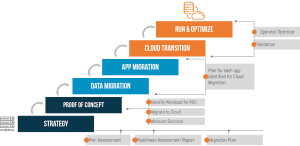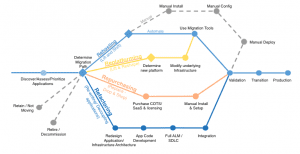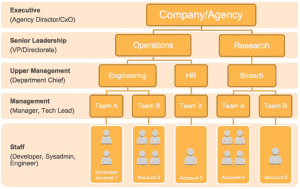With the advancement in technology and fast-changing business demands, cloud-based solutions have become a more flexible and powerful option for organizations. Mass migration is underway to adopt cloud infrastructure and avoid the hassles and operational costs of managing infrastructure in-house. Moving IT infrastructure to the cloud has become necessary for many organizations. However, cloud adoption is not a straightforward path. The migration of enterprise legacy applications or rehosting the infrastructure from the data center to the cloud can quickly go south if not appropriately planned.
As per a study report: 41% of enterprise workloads will be run on public cloud platforms by 2021. While companies state cloud migration is pivotal to their business strategies, most struggle in creating a cloud migration project plan.
Thus, it’s time to revamp your cloud migration strategy for better business processes and avoid disruption. Before that, let’s briefly understand what cloud migration is & benefits of migrating on the cloud.
What is cloud migration?

Cloud migration refers to moving an organization’s data, applications, and other elements into a cloud computing environment. The type of cloud-to-cloud migration depends on what the organization wants to achieve from digitization. One of the most common models is to transfer data and applications from an on-premise data center to the public cloud. Here’s how an organization typically performs cloud migration with the correct set of cloud migration tools:
Today, more and more organizations are moving their data and business processes to the cloud. So let’s start by discussing why they believe cloud migration is critical for their growth.
What are the benefits of cloud migration?
Right from apps and data becoming easily accessible to different teams to make their day-to-day processes more efficient, there are several reasons why businesses are moving to the cloud. But here are the ones that make on-premise to cloud migration a definite choice for most:
1. Reduced IT costs: Using resources like public cloud services results in paying as per use. This dramatically reduces costs, bringing down the upfront capital expenditure required to implement and maintain on-premise equipment. With capital and operational spending reduced, businesses can invest more in growth strategies and innovations.
2. Digitization of business: AWS cloud migration enables organizations to optimize their business processes and activities more efficiently. A well-thought-through cloud migration strategy can help companies to become more efficient by leveraging a mix of digital technologies.
3. Growth-focused: With cloud migration services, you move many processes to the public cloud. This removes a lot of time-consuming activities in managing your IT infrastructure and platforms from your plate. With more time and resources, you can focus on business-driven activities like creating value for customers, innovations, and driving more revenue.
4. Agility in business:
The only way to last in a competitive industry is to move fast against challenges and tap into market opportunities at the right time. The public cloud provides this agility to businesses with accessible infrastructure and resource scalability. Companies can take on newer projects without having to worry about base-level requirements.
While the benefits are hard to miss, an organization must have the right cloud computing strategy. Certain things must be considered when executing a cloud-to-cloud migration.
What are the best practices to avoid disruption during Cloud migration?
Organizations follow their cloud migration strategies based on the resources, technology, and skills available to them. While some successfully implement the cloud in their processes effectively, others struggle to migrate their data. That’s why, as advanced AWS cloud service providers, we assemble the cloud migration best practices we swear by.
1. Create a cloud migration strategy
The first thing to do in a cloud migration process is create an outline. Begin by mapping out your business motives, use cases, and reasons for moving to the cloud. Break your cloud migration strategy into phases to reduce disruption risks and ensure efficiency.
[Also Read: The Essentials Of An Effective Cloud Migration Strategy ]

Source: AWS
Here are 6 R’s for Migrating Applications to the Cloud
- Rehosting: This strategy comes into play when there is a significant legacy migration scenario. In this case, organizations want to scale their migration quickly to meet new business needs. So they rehost most of their applications instead of developing new ones using cloud-native capabilities.
- Replatforming: In this strategy, you’re considering your existing architecture of the application and considering making optimizations to drive more benefits out of it. For instance, you could spend less time managing database instances by migrating to a database-as-a-service platform.
- Repurchasing: As the name suggests, this part of the strategy is about considering moving to a different product during migration. Usually, companies can be seen moving to a SaaS platform at this stage.
- Refactoring/ Re-architecting: Use this strategy to fulfill vital business needs. Be it adding new features to an existing application or scaling it to perform better than its current environment, this is where you strategize how the application will be architected and developed using cloud-native features.
- Retire: This is the strategy where you remove the IR portfolio that is no longer in use or can be simply turned off. To verify their usage, you must consider each functional area that owns the applications. Cutting out waste lessens the surface area you need to secure during the migration, directing the team to focus on resources that matter.
- Retain/ Revisit: As a thumb rule, you should only be migrating applications that are currently being used by your business. If you aren’t sure about an application that was recently upgraded or are not inclined to migrate them, you can revisit those later as your IT portfolio changes.
2. Establish a governance framework
Compliance and security are top concerns for organizations moving to the cloud. Creating a governance framework helps you set policy-based rules to prepare for secure cloud adoption in various business processes. The framework considers the risks of using third-party services and defines how to use different tools. It also documents the organization’s structures, roles, responsibilities, objectives, policies, and decision-making framework.
AWS designed governance as a scale framework to conform to an organization’s structure and business processes. You can read all about it here.

3. Optimize the cloud network :
Cloud migration takes a lot of your business processes to the public cloud. The network used by the cloud is the public internet by default. So if your organization is worried about the internet being too slow or not too secure, contact your internet service provider for optimized speed or choose Amazon web services cloud migration. They offer a dedicated network connection to their infrastructure.
4. Upskill your team on cloud migration :
Most companies face cloud migration challenges due to a lack of expertise. So when you’re working on the cloud-to-cloud migration, train your team too. Ask your AWS cloud migration service provider for training sessions to get different departments up-to-speed with cloud concepts.
5. Ensure software licensing :
When creating your cloud migration strategy, document all enterprise applications and software. Remember to go through their licensing rules concerning cloud computing services. If you’re unsure, remember to talk to the vendor to see if the licenses you’ve purchased are suitable or can be updated for usage.
Pro tip: Use a software asset management tool. It helps you reduce the risks, costs, and complexities associated with license management in the cloud.
6. Implement automations :
The one thing you need to ensure during cloud migration is to avoid service disruption. Downtime for your business could mean a loss in efficiency and overall revenue. To minimize the risk of downtime, automate repeated patterns in your process wherever possible. It will lower the risk of disruption and speed up the cloud-to-cloud migration. Several cloud migration tools can help you implement this automation while executing the strategy.
7. Monitor usage of cloud services :
According to Forbes, about 35% of cloud budgets get wasted. That’s why you need to monitor your usage when you’re working on the cloud-to-cloud migration. Identify running instances across the different cloud migration services and collect logs from the apps, databases, and network touchpoints you’re using. Since moving to the public cloud means you’re paying as per your usage, this will help you ensure that your IT requirements are being met on optimized budgets.
Pro tip: Also monitor for industry compliance and security continually.
8. Leverage cloud service provider support :
Executing an AWS cloud migration strategy without any disruptions can be overwhelming. So instead of tackling it all in-house, you can get support from an AWS cloud service provider. They are equipped with the right software and have vast experience in helping similar businesses move to digitization.
Why should you invest in Cloud Migration?
Industry study shows that cloud computing services are expected to reach $68.4 billion by 2021. Organizations will be seen using the cloud for different purposes, be it public, private, hybrid, or a mix of computing models.
To conclude, cloud migration is needed as businesses target becoming more efficient at processes and agile. But creating an AWS cloud migration strategy and moving through the steps requires the right skills and technology.
That’s where choosing an AWS cloud service provider like Rapyder comes into the picture. As an advanced AWS consulting partner, the team has years of expertise in strategic cloud consulting, DevOps automation, managed services, and security consulting. We don’t just ensure following all the cloud migration best practices but also educate your organization’s employees on how the cloud changes their day-to-day processes for easy adoption.
Want to learn more about cloud migration and how your business can benefit from it? Contact us today




